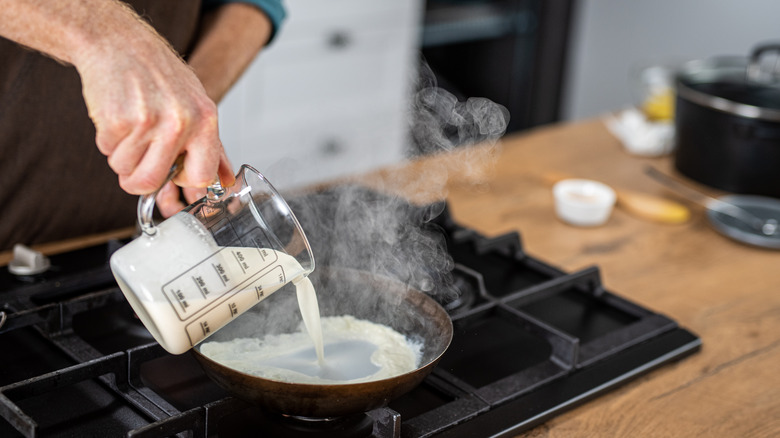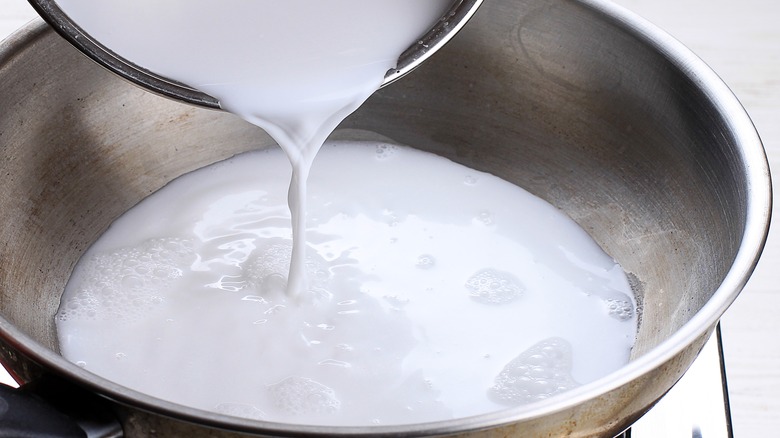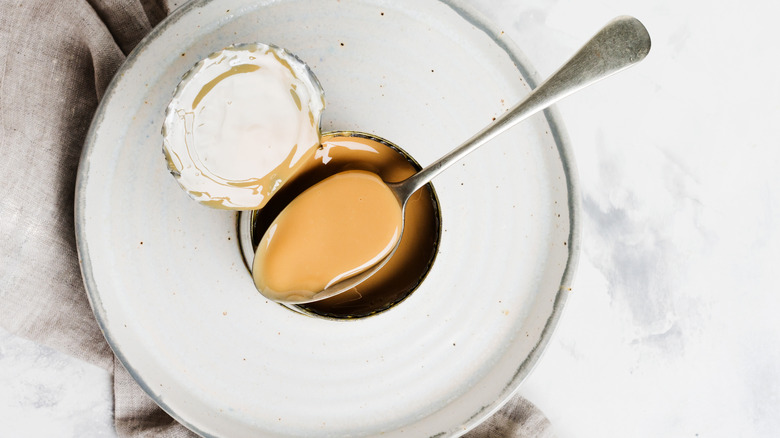The Simple Tip For Evaporating Your Own Milk
Evaporated milk is pretty much exactly what the name suggests: Milk that's been evaporated (that is, boiled) down to a thicker version of itself with less water. So if you find yourself needing to use evaporated milk for a recipe, it's actually very simple to make at home. Throw that milk in a pan on the stovetop, turn up the heat, and wait until it's reduced.
The only trick is knowing how much to reduce it by — and there's multiple ways to approach this. Some sources say you should let it boil down to half the volume, others say you should get 60% of the milk's water content to evaporate (a complicated calculation considering that water isn't the only component of milk — there's also fat in there), but a standard recipe asks you to start with 2 ¼ cups of milk and boil it down to 1 cup. To figure out when you've boiled it down enough, you may need to pour the milk from the pot into a measuring cup. Alternatively, you could use a skewer to try measuring the reduction; place it upright in the pan before you turn the heat on, mark the height of the milk on the skewer, and then use that mark to (roughly) assess when you've evaporated more than half the milk away.
The nuances of homemade evaporated milk
One catch with making your own evaporated milk is that the amount of evaporation you need will vary depending on what milk you use. The idea is to get a creamier product with a higher fat-to-water ratio. Recipes for evaporated milk at home don't really specify whether you should use 2% or whole milk, so if you're making it at home, you should be prepared to accept that it's an ambiguous process.
But here's a quick explainer to guide you: If you're starting with milk that's fattier (say, 3.25% whole milk, or something beyond that), you should get a sufficiently creamy result without boiling it down as much as 2% milk. On the flip side, if you're trying to use low-fat milk (around 1%), you'll need to evaporate a lot more of it to get a creamy result — and it's probably not worth even trying with skimmed milk that has little-to-no fat.
Bear in mind that you can also reduce your homemade evaporated milk according to your taste. If you boil it down more, it'll be richer and creamier (since there will be more fat relative to the water content of the milk), and that should carry into whatever recipe you're making.
Is it worth evaporating your own milk?
There's no verdict on whether evaporating your own milk is better than just buying it in the store (and to be clear: Evaporated milk is not the same as sweetened condensed milk). If you make your own batch using high-quality milk, then you may end up with a tastier evaporated version, but if you're using a more standard milk, there may not be much difference from the canned version. However, if you're trying to avoid an extra trip to the store, evaporating it yourself at home is still a good move, although you'll need the extra time for the milk to reduce.
If you're really looking to save, it's a little cheaper to evaporate your own milk. For example, a 12-ounce can of cheap evaporated milk at Walmart is $1.26 — that's equivalent to 24 ounces of regular milk. (Remember, evaporated milk is milk that's been reduced by at least half, one portion of it represents at least double the same volume of regular milk.) But for $1.58, you can get a half-gallon (64 ounces) of regular milk. If you made evaporated milk with that, you'd end up with around 32 ounces for just a few cents more than the 12-ounce can of evaporated milk.


